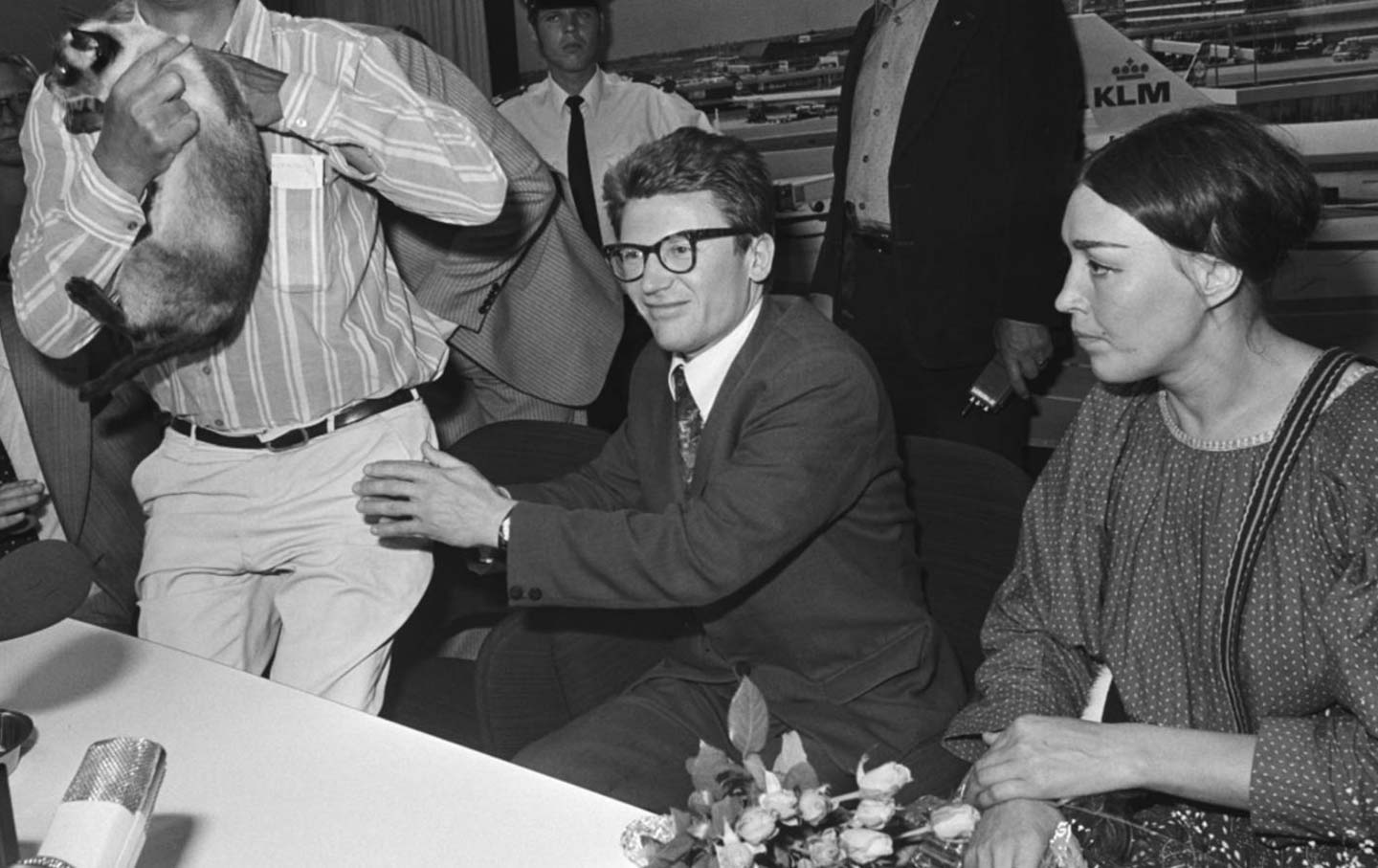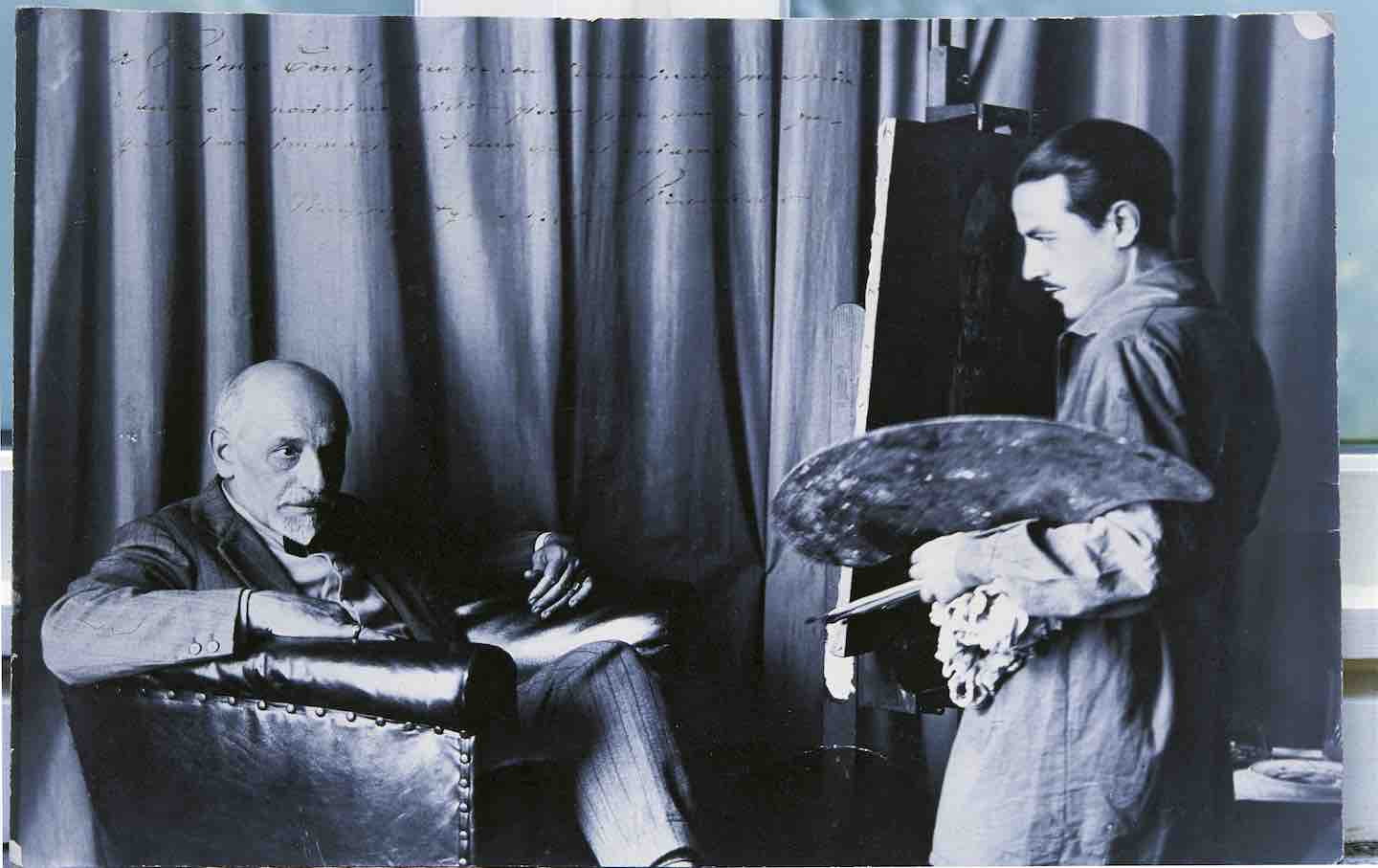Chain Reactions
The often misunderstood history of the Soviet dissident movement.
The Often Misunderstood History of the Soviet Dissidents
In To the Success of Our Hopeless Cause, historian Benjamin Nathans sheds light on how the protest movement reinvented itself at key junctures and eventually to great effect.

Why do some activists and intellectuals risk everything for the sake of a seemingly unwinnable struggle? To the dissidents of the Soviet Union, that question was so relevant that it became a famous and ironic toast. Supposedly introduced to dissident circles in the early 1970s by Naum Korzhavin, a Jewish poet radicalized by the 1966 trial of the writers Andrei Sinyavsky and Yuli Daniel, it went: “To the success of our hopeless cause.”
Under Joseph Stalin, the Soviet Union had no lack of dissent or hopelessness, but there was nothing like a cause—at least in the sense of an organized movement. Autonomous civil and professional organizations had been systematically dismantled under Vladimir Lenin in the early 1920s, and organized opposition was rendered impossible even before the mass violence of the Great Terror in the late 1930s. But during Nikita Khrushchev’s Thaw of the mid-1950s, as the Gulag was emptied and Stalin’s crimes condemned, a space also opened up for a cause, which was sparked to life after Leonid Brezhnev reversed Khrushchev’s reform communism. Even as the cause shaped the lives of thousands in the 1960s and ’70s, it was nonetheless plagued by a certain hopelessness. This was, after all, still a world in which public criticism could quickly lead to the end of one’s career, imprisonment, confinement to a psychiatric hospital, or exile.
Taking Korzhavin’s toast as its title, a new book by Benjamin Nathans dissects the history of the Soviet dissident movement from its rapid rise in the mid-1960s through its almost complete rout in 1982, just years before a second bout of reform communism, Mikhail Gorbachev’s perestroika, appropriated its key concepts of transparency (glasnost) and the rule of law. To the Success of Our Hopeless Cause sheds light on how this seemingly marginal protest movement, largely rejected by much of the society from which it sprang, nonetheless reinvented itself at key junctures and eventually to great effect. It also sheds light on the risk-takers themselves: an extraordinary cast of characters, many of whom remain largely unknown internationally.
Western journalists during the Cold War tended to focus on a handful of prominent dissidents, treating them as the leaders of a movement that saw itself as leaderless and misunderstanding them as anti-Soviet or Western-style liberals. But as Nathans shows, many of the Soviet dissidents were, in fact, instinctively anti-ideological and, beneath the surface of their opposition to Soviet hyper-politicization, strikingly diverse in their political and intellectual orientations. They demanded freedom from an overweening statism, and they demanded rights. However, the key to their outlook and unity was not any explicitly articulated loss of faith in socialism—some dissidents remained Marxists or Leninists, while others became liberals or nationalists only later—but rather that they understood the struggle for human rights as an alternative to politics: a way for individuals to escape the all-encompassing claims of an official ideology managed by the party-state. The dissidents never aimed for the overthrow of the Soviet state, and even after they turned to outright opposition, they remained shaped by the norms of Soviet society and inspired by the ideals of Soviet humanism.
If the dissident movement’s identity revolved around a shared understanding that it had no leaders, no political program, and no ideology, it did have something of a founder: Alexander Esenin-Volpin. The son of the famous lyric poet Sergei Esenin (who committed suicide in 1925), the unkempt Volpin—the unhyphenated name on his passport, as he was born out of wedlock—was an outspoken eccentric who could sometimes be seen walking the streets of postwar Moscow in his tapochki, or house slippers.
Nathans describes Volpin as an “instinctive contrarian” from a young age, and that was certainly the case. Born in 1924 in Leningrad, Volpin entered Moscow University to study mathematics in August 1941—shortly after the Nazis invaded. Evacuated to Ashkabad in the Soviet republic of Turkmenistan, he became known as a talented poet, but by the time he received his graduate degree in mathematics in 1949, he had also immersed himself in analytic philosophy. Soon the mathematician turned poet turned logician broke with the system after his poetry and outspokenness landed him first in prison, then in a psychiatric hospital, for being a “socially dangerous element.” When Volpin returned to society, he immersed himself in the stringent logic of Soviet cybernetics and began to train his singular outlook against the political system.
In 1959, Volpin composed Free Philosophical Tractate, a work that had been gestating for years but that he bragged was written in one day. Smuggled out by a member of the Yale Russian Choir and published in New York in 1962, the book championed the primacy of metaphysical truths over the Marxist notion that ethics and law are determined by the economic base. Volpin’s blend of Soviet and Western influences converged as a challenge to not merely the Communist Party’s appropriation of truth but the deeper conventions of Russian-Soviet intellectual life: its “contempt for juridical formalities” and its “lingering romance with revolution as the paradigmatic form of historical change.” Volpin, in other words, may have been an eccentric, but the very idiosyncrasies of his Soviet path—not the ideas of classical liberalism—had turned him into an adroit and determined champion of the rule of law as the central tactic for the first human rights movement in the communist world.
If this made Volpin distinctive among many of his friends in the intelligentsia, it also distanced him, at least at first, from many of his fellow proto-dissidents, who were skeptical of Volpin’s legalism. They viewed his insistence that the USSR follow its own Constitution and criminal code as utopian, given that the ruthless party and the KGB rejected any hint of binding legal constraints as “bourgeois.” But soon enough they, too, began to realize that Volpin’s legal strategy was not in fact quixotic but extremely practical, in part because it fueled the remarkable publicity that the dissident movement gained internationally by linking it to the cause of civil and human rights abroad.
It also proved strikingly successful in flummoxing the KGB during interrogations. The 1960s were a period when the post-Stalinist authorities, who had committed themselves to avoiding the widespread use of torture and the mass terror of Stalinism, were deeply concerned about international opinion and so felt constrained by the laws they’d simply ignored in an earlier era. If the dissidents were only advocating that the Soviet Constitution and Soviet laws be respected, how could they be punished for anti-Soviet activity?
Much like Volpin, another early dissident, Andrei Amalrik, was also born a contrarian. Known for his “brash, fearless, and abrasive personality,” Nathans writes, Amalrik was first arrested in 1965 on the charge of pursuing a “parasitic and anti-social way of life.” Even if there were considerable differences between Volpin’s fidelity to logic in all spheres and Almarik’s fierce individualism, the latter would become an energetic convert to Volpin’s legal activism. During the late-’60s waves of protest and petition-signing, as the dissident movement proliferated in the wake of the Sinyavsky-Daniel trial, Almarik, the hater of rules, “learned to deploy Volpin’s strategy of legal formalism.”
Almarik was a singular figure in the movement: He personally refused to sign petitions or take part in demonstrations because of, as he put it, his intense “dislike for collective actions.” But he nonetheless advanced the notion that the risky act of signing—of turning oneself into a podpisant, a signatory—was a crucial step in the Soviet citizen’s self-liberation. Committing oneself in this way represented a cathartic step capable of cutting through hypocrisy and doublethink.
Almarik’s importance to the nascent dissident movement was found not only in his embrace of Volpin’s legal strategy; it also lay in his critique of the educated, urban, relatively privileged segment of society, which had developed what he called a “cult of its own impotence.” Almarik’s 1970 extended essay, Will the Soviet Union Survive Until 1984?, caused a sensation not only because of its now seemingly prophetic premise, but also because of its coolly analytical mode of analyzing Soviet politics and society. Almarik did not single-handedly invent the vision of inner freedom that he articulated in that essay. But he both epitomized and theorized a second indispensable ingredient—individual self-emancipation—that augmented the impact of the dissident cause. Armed with an effective legal strategy and a compelling model of personal freedom, a free-flowing, often amorphous, always evolving human rights movement began to take shape in the mid- to late 1960s. It also started to achieve success far beyond its tiny numbers. These dissidents did something quite remarkable in a highly authoritarian context: They began to think and behave as if they were free.
To think and behave as if one were free can mean different things, and Nathans catalogs these differences brilliantly, offering us a fascinating cast of characters almost as extensive as that in a novel by Tolstoy or Dostoevsky. On a more literal level, this is clearly what Nathans means by the “many lives” of his book’s subtitle. But that “many lives” refers to something else as well: the successive incarnations of the dissident movement over time.
Popular
“swipe left below to view more authors”Swipe →The Sinyavsky-Daniel trial was the immediate spark behind the first incarnation of the dissident movement: It led to a wave of post-trial petitions by courageous individuals eschewing pseudonyms and to the new medium of samizdat (self-publishing) as the movement embraced Volpin’s legal strategy. This led in turn to what became known as the “chain reaction,” fueling a meteoric rise between 1966 and 1968 that culminated in a civic movement for rights disseminated by samizdat across the vast multiethnic expanse of the USSR.
But from there the movement found itself in a state of persistent change. The early dissidents consolidated a committed core in the cultural and political power center of Moscow around the simple demands for basic rights and accurate information. But social movements, as Nathans observes, are not like institutions: They need periodic successes and cannot survive by standing still. By the early 1970s, a drawn-out battle of attrition with the powerful Soviet authorities, spearheaded by the KGB, led to a demoralized nadir for this first wave of dissident activity. The height of the secret police’s success came when it flipped two key figures, Petr Yakir and Viktor Krasin, by playing on their desires to become leaders of the leaderless movement.
The KGB crackdown that followed was part of the emergence of a more hard-line and ideologically conservative phase of the Brezhnev period, which turned away from even moderate reforms and enforced orthodoxy through extrajudicial reprisals. The dissidents struggled under these conditions; for a time, they were even prevented from publishing their samizdat magazine Chronicle of Current Events, which reported on imprisonments, the persecution of religious and ethnic minorities, and other human rights violations.
At this low point, the dissident movement underwent a remarkable reinvention. In some of his history’s most original chapters, Nathans shows how the movement reconfigured itself into a cluster of small yet surprisingly effective, Western-oriented dissident initiatives akin to NGOs, which at that point were emerging as the engine for international human rights advocacy. The last third of the book examines this more mature dissident movement and its organizations, charting their paths not only in the Soviet Union but abroad as well.
The story of this later phase of dissident activity is one of misunderstandings and marriages of convenience, in which Soviet dissidents learned to cooperate with Western journalists and especially the new Western start-up human rights organizations, reaching across not just language barriers but often radically different outlooks and assumptions. All the major players—Soviet dissidents, rising human rights NGOs such as Amnesty International, Western journalists, governments, and the influential shortwave radio broadcasters from Voice of America and many others—formed alliances and, even with all their miscommunications, influenced one another.
This particular “life” of the dissident movement culminated in the 1975 Helsinki Accords, negotiated among 32 European countries along with the United States and Canada. Brezhnev gained a long-elusive legitimation for the borders of the postwar Soviet bloc, convinced that the Soviet leadership was giving nothing in return except unenforceable commitments about the international monitoring of human rights. Yet for the dissidents’ Helsinki Group, the accords represented something far more significant: As Nathans writes, it created a “chain reaction, but now at a higher level,” and established remarkably effective monitoring organizations in Moscow, Kyiv, Tbilisi, Vilnius, and Yerevan.
Perennially shunned by their own government, the dissidents nonetheless leveraged US involvement in the accords and thus came to influence superpower politics. This provoked KGB chief Yuri Andropov to make more martyrs out of the organization’s members by leading another harsh crackdown on human rights activists—a repression that in turn contributed to the end of Soviet-Western détente. “Never before,” Nathans observes, “had dissidents had such a tangible impact on the USSR’s relations with the West.”
Even as the dissidents helped shape global politics in a way they had never imagined was possible before, they found that—in a reprise of the cycle of growth and repression that defined the history of their movement—their victory contained the seeds of a subsequent defeat. By the early 1980s, the KGB had succeeded once again in almost completely breaking the human rights movement. The dissidents in this period didn’t help themselves either. Coming overwhelmingly from the intelligentsia, they largely failed in their hope to change the legal consciousness of ordinary citizens. Moreover, they had no base of support: Many of those ordinary citizens bought the message of Soviet propaganda and KGB “active measures” that the dissidents were traitorous pawns of the USSR’s Western antagonists. The dissidents had markedly more sympathy among non-Russian national or religious minorities, including Lithuanian Catholics, the Ukrainian national movement, and Jewish refuseniks. But they were never able to achieve the mass backing, not to mention the eventual judicial and governmental support, enjoyed by the far more overtly successful US civil rights movement, which also embraced a legal strategy as its centerpiece (using appeals to federal law to overcome Jim Crow segregation).
Given the dissidents’ isolation and virtual defeat in the early 1980s, how can we assess the overall impact of their cause? There is a strong case to be made that the movement sapped the legitimacy of the Soviet order by exposing the state’s unwillingness to uphold its own laws. Years after the activists’ ostensible defeat, moreover, Gorbachev endowed dissident ideas with a “new life.” Two key parts of perestroika—glasnost and “democratization,” which Gorbachev insisted in 1988 could only be achieved through a state governed by the rule of law—seemed to draw directly from the dissidents’ lexicon. Both sparked unintended consequences that by 1991 would help to unravel the entire Soviet system.
Nathans might have spelled out more explicitly one conclusion embedded in his later narrative. Even if the dissident movement indirectly and partially helped set into motion some of the processes leading to the Soviet Union’s collapse, its lack of attention to institution-building was part of a much broader mentality that led to a distinctly Pyrrhic victory. There would be no “transition” to a lasting pluralistic order, but rather the rise of a new and even more virulent illiberalism.
In the age of Vladimir Putin, not to mention the second coming of Donald Trump, To the Success of Our Hopeless Cause would seem to convey two hopeful messages: that committed and courageous individuals can have an outsize impact, and that protest movements can adroitly reinvent themselves even in their darkest hour. At the outset of his book, Nathans avows that “the story of Soviet dissent illuminates a deeper struggle between hopelessness and perseverance in the contemporary world.” But he concludes his book on a different note: The dissident movement can become a “usable past” in contemporary Russia, he writes, only after the country finds its way to “political pluralism and the rule of law.”
Were Volpin alive, he might conclude that Nathans has violated the logic of his own historical exposition. It is clear enough that Volpin’s legalistic strategy would hardly work under a distinctly harsher and very different political conjuncture. But why does that negate the usability of the dissident past? Russians today, of course, cannot simply copy the tactics of their forebears. New dissidents will need to invent and reinvent their own cause, as Volpin did during the Thaw and as the most determined activists did again in the 1970s. If they had waited for the country as a whole to change, they never would have achieved anything.
In today’s Russia, the phenomenon of widespread conformism and apathy that the Soviet-era dissidents confronted has reappeared as a crucial part of the country’s trajectory. Even many of today’s most committed Russian oppositionists seem inclined to dismiss their predecessors as ineffectual Don Quixotes. Yet that Soviet-era stereotype concealed a resilient creativity and unlikely effectiveness revealed throughout this book. This alone makes for a compelling reason to translate Benjamin Nathans’s magnum opus into Russian.
Disobey authoritarians, support The Nation
Over the past year you’ve read Nation writers like Elie Mystal, Kaveh Akbar, John Nichols, Joan Walsh, Bryce Covert, Dave Zirin, Jeet Heer, Michael T. Klare, Katha Pollitt, Amy Littlefield, Gregg Gonsalves, and Sasha Abramsky take on the Trump family’s corruption, set the record straight about Robert F. Kennedy Jr.’s catastrophic Make America Healthy Again movement, survey the fallout and human cost of the DOGE wrecking ball, anticipate the Supreme Court’s dangerous antidemocratic rulings, and amplify successful tactics of resistance on the streets and in Congress.
We publish these stories because when members of our communities are being abducted, household debt is climbing, and AI data centers are causing water and electricity shortages, we have a duty as journalists to do all we can to inform the public.
In 2026, our aim is to do more than ever before—but we need your support to make that happen.
Through December 31, a generous donor will match all donations up to $75,000. That means that your contribution will be doubled, dollar for dollar. If we hit the full match, we’ll be starting 2026 with $150,000 to invest in the stories that impact real people’s lives—the kinds of stories that billionaire-owned, corporate-backed outlets aren’t covering.
With your support, our team will publish major stories that the president and his allies won’t want you to read. We’ll cover the emerging military-tech industrial complex and matters of war, peace, and surveillance, as well as the affordability crisis, hunger, housing, healthcare, the environment, attacks on reproductive rights, and much more. At the same time, we’ll imagine alternatives to Trumpian rule and uplift efforts to create a better world, here and now.
While your gift has twice the impact, I’m asking you to support The Nation with a donation today. You’ll empower the journalists, editors, and fact-checkers best equipped to hold this authoritarian administration to account.
I hope you won’t miss this moment—donate to The Nation today.
Onward,
Katrina vanden Heuvel
Editor and publisher, The Nation
More from The Nation

The Best Albums of 2025 The Best Albums of 2025
From Mavis Staples to the Kronos Quartet—these are our music critic’s favorite works from this year.

Forrest Gander’s Desert Phenomenology Forrest Gander’s Desert Phenomenology
His poems bridge the gap between nature’s wild expanse and the private space of one’s imagination.

Capitalism’s Toxic Nature Capitalism’s Toxic Nature
A conversation with Alyssa Battistoni about the essential and contradictory nature of capitalism to the environment and her new book Free Gifts: Capitalism and the Politics of Nat...

Solvej Balle and the Tyranny of Time Solvej Balle and the Tyranny of Time
The Danish novelist’s septology, On the Calculation of Volume, asks what fiction can explore when you remove one of its key characteristics—the idea of time itself.

Muriel Spark’s Magnetic Pull Muriel Spark’s Magnetic Pull
What made the Scottish novelist’s antic novels so appealing?

Luigi Pirandello’s Broken Men Luigi Pirandello’s Broken Men
The Nobel Prize-winning writer was once seen as Italy’s great man of letters. Why was he forgotten?


